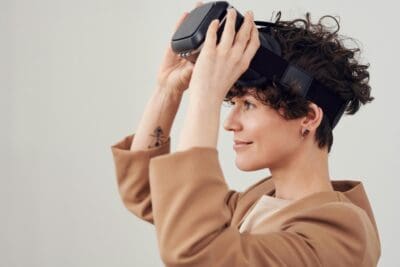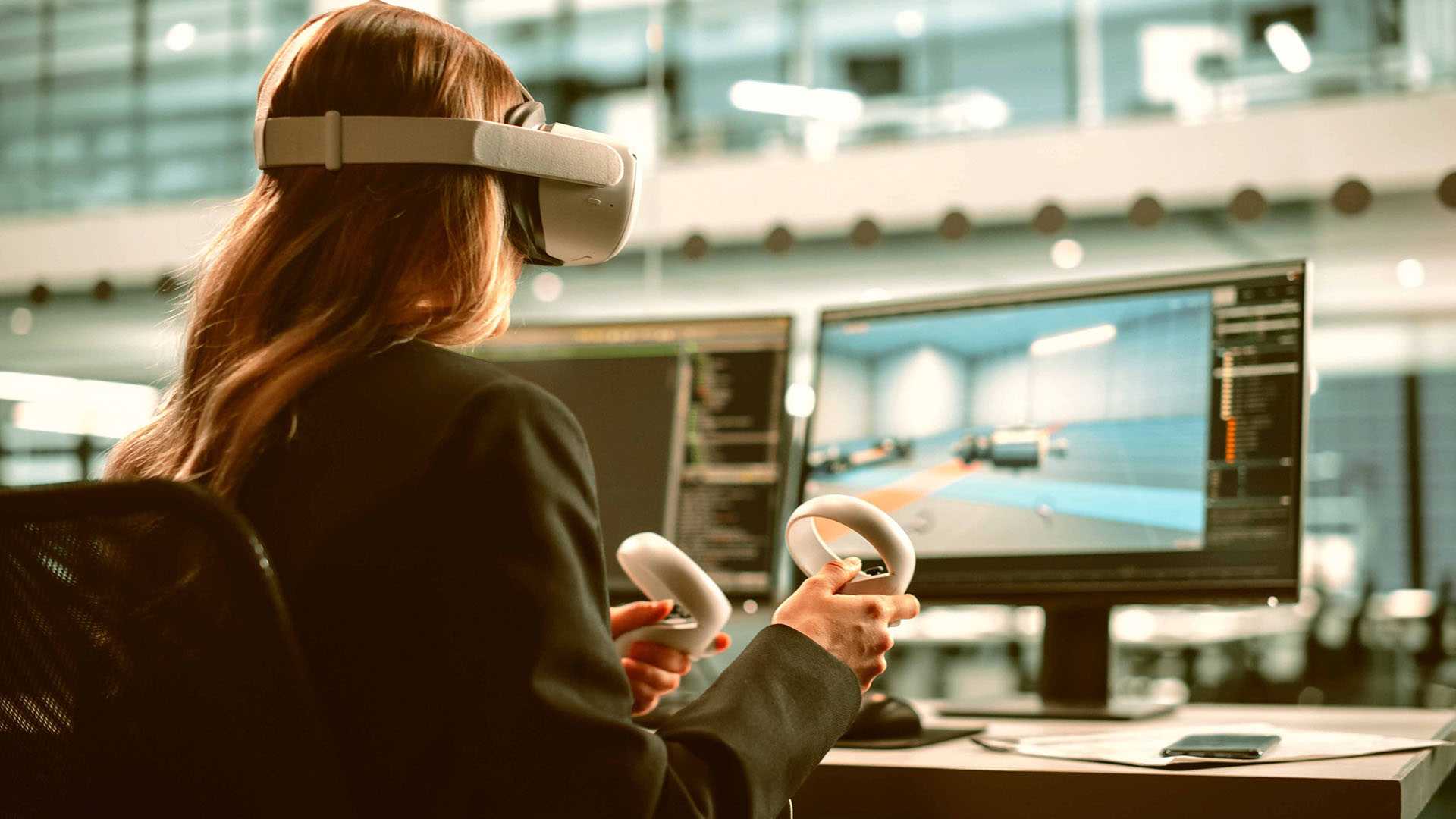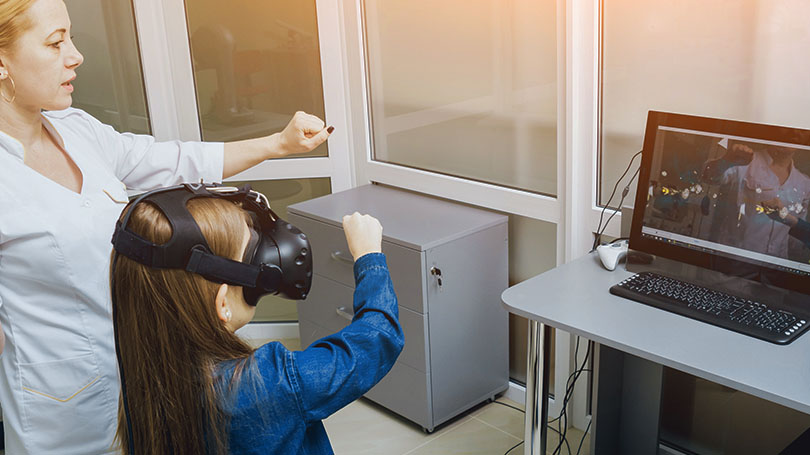
Fulfilling the Promise of an XR and Real-Time 3D Powered Future of Work: Four Guiding Questions.
January 29, 2024
At a Glance
How industry leaders can use Extended Reality (XR) and Real-Time 3D technologies to make workforce development, education, and the workplace more equitable.
We’ve seen the power and promise of extended reality (XR) and real-time 3D (RT3D) technology for our workplaces and classrooms, from creating virtual environments where students can safely practice new skills to the emergence of new occupations and career pathways that rely on technical knowledge of these immersive tools. However, a range of systemic barriers—including digital literacy gaps, a lack of high-speed internet access, expensive hardware and software systems, and unclear career pathways into the jobs building XR ecosystems—are limiting the impact of these solutions to change people’s lives and career trajectories. As this technology and the ecosystem surrounding it grows and matures, we need to do more to help its promise truly reach everyone.
XR and RT3D technologies have been around for decades and are becoming more accessible, usable, and cost-effective, offering an ever-widening scope of experiences. Despite this flourishing of technological capabilities, we’re just scratching the surface of their full potential to impact how we work and learn. At the same time, these rapid advances are raising new questions about how we need to design and implement XR and RT3D tools to ensure workers and learners benefit equitably.
In 2020, JFFLabs released a groundbreaking market scan that highlighted leading innovators developing immersive learning technology for workforce training. Since then, we’ve explored the many ways in which this technology is already shaping the future of work and learning. We’ve incubated startups, led demonstration projects and innovation challenges that use XR technology for talent and business development goals, and we’ve supported community colleges offering training in XR skills—directly impacting hundreds of learners, workers, and organizational leaders across sectors—supported by partners such as Meta and SAP.
To highlight just one example, we’re seeing clear evidence of increased learner engagement and confidence from using XR and RT3D training, as well as more knowledge retention, both in field research and in the many anecdotes from the learners we serve and the partners we work with in communities across the country. In addition, as the usage and market for these technologies grow, so will the career pathways that require XR and RT3D-related skillsets.
As the transformational power of this technology increasingly reveals itself, JFF and our partners are looking beyond the current state of XR to ask how we might accelerate its potential to drive economic mobility.
With support from Unity’s Social Impact team, JFFLabs is bringing together a group of industry experts, technologists, and workforce and education practitioners who are leading the field in their application of XR and RT3D tools through a new engagement model we’re calling the “Metaverse for All Innovation Circle.” Over the course of this year, this group of leaders will examine different solutions, models, partnerships, lessons, and use-cases across sectors to develop a set of principles for designing, building, and deploying XR and RT3D tools within organizations serving workers and learners, especially those from communities that have been excluded from opportunities for economic advancement.
Together, we’ll dive into how this technology can benefit people, products, organizations, and the systems and culture that determine how we work and learn. Four design questions will guide our research:

Distribute Skills Equitably | People:
How can we ensure that the skills required to design, build, deploy, and maintain XR and RT3D solutions and content are distributed equitably?
As this industry grows, so will the occupations and career pathways that underlie the technologies, from programming to hardware design to content development, and beyond. Many of these occupations, like many in the technology sector, are not fully representative of underserved populations. As we champion this industry and the opportunities it offers learners and workers, we need to make sure we’re building a system that provides high-quality skills training and career pathways for all.

Incorporate Worker and Learner Voice | Products:
How can we ensure that incorporating the lived experiences of people facing barriers to economic advancement is standard industry practice in the development and deployment of XR and RT3D technologies?
Through the Skill Immersion Lab, which deploys XR and RT3D products in school districts across the country, we’ve seen how XR solutions can be a powerful tool for student expression. For example, students in traditional and alternative high school programs created their own learning modules that reflected their lives and were relatable to them and their peers. For us, incorporating worker and learner voices into content creation is just the beginning. We want to make sure their perspectives are considered earlier and more fully in product design and development so these tools can be more accessible, engaging, and high impact.

Lowering Barriers for Organizations | Organizations:
How can we lower barriers to adopting XR solutions?
The power of XR and RT3D to improve how we work and learn is limited if it stops with early adopters. Ensuring that everyone has what they need to use these technologies effectively, and understanding when those needs differ across stakeholder groups, will be critical for scale. For example, JFF works with small businesses on skills training demonstration projects in partnership with Meta. Through this work, we’ve gained a deeper understanding of what it takes for small businesses to access to this technology and deploy it successfully to benefit their workers and achieve business goals. Equitable access to technology will require reducing not just the financial costs of hardware and software, but also the time needed for educators and supervisors to learn the technology and to share that knowledge with their learners and workers. It will also require technology solution providers to find innovative ways—such as the integration of generative AI—to develop content for small businesses and others for whom the cost of traditional customized content may be out of reach. Finally, reducing barriers will also require new policy infrastructure to support adoption and ensure data security and privacy, necessitating the education and support of policymakers and government agencies.

Unlocking Opportunity vs. Perpetuating Inequity | Systems:
How can we ensure XR technology enables worker and learner opportunity and doesn’t perpetuate existing inequality in our employment and education systems?
Like all technologies, XR and RT3D are tools to achieve a human goal—and the most critical factors that determine their impacts are how (and where, when, with whom, why) they’re being implemented and for what purpose. While XR and RT3D technologies may increase learner core skills and knowledge retention, they also promise to change how students and teachers engage with each other, potentially shifting dynamics that have been ingrained in education since the Industrial Revolution, such as lecture-based classrooms or curricula and assessments that don’t take into account the variety of student learning styles. However, this promise won’t be realized if new technologies are used only within existing, rigid structures. We need to better understand these potential technology-driven changes. Similarly, while XR and RT3D tools can improve skills training, there is very little evidence yet about whether and how they can be applied to job tasks to improve worker experience and job quality.
Over the next several months, the Innovation Circle will dive deeply into these questions. Our goal is to establish a “What’s Next” impact agenda, setting out recommendations for future activities, investments, learnings, and outcomes across the workforce and education landscape.
As we advance in our exploration, we want to hear about your XR and RT3D experiences as well. What questions does this learning agenda raise for you? Do you have insights to share about how you’re seeing these technologies shape the future of work and learning? We’d love to hear from you—contact us today. If you’re interested in learning more about this work, visit www.jff.org/xr.
Related Content

JFFLabs Insights
Fueling innovation through research, story sharing, and rich analysis. Our systems and institutions are under enormous pressure to adapt to rapid change. Innovators, technologists, and entrepreneurs are seizing the moment to design and build solutions…

2020 Immersive Learning Technology
Advances in immersive technologies create new opportunities for companies, educational institutions, and training providers to build engaging, effective, and affordable systems for training people in simulated environments. At JFFLabs, we scan markets to identify promising…

JFFLabs
Driving innovation through insights, incubation, and investment. New technologies and models are radically transforming our workforce and education systems. These shifts create opportunity but also risk reinforcing systemic inequities. Promising solutions that maximize learner opportunity…